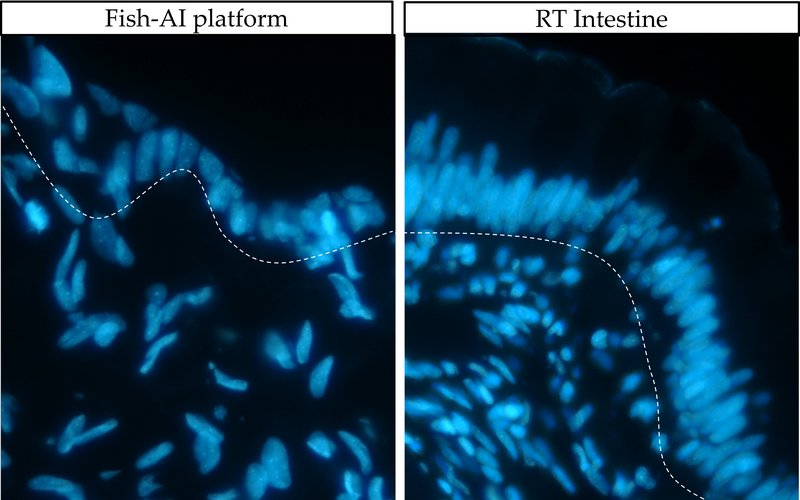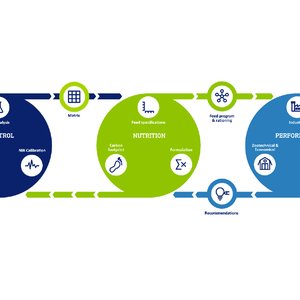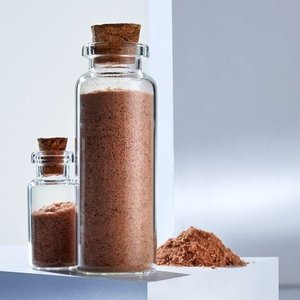From the desire to translate scientific research into practical solutions, the European Fish-AI project was launched to develop an artificial intestine for the aquaculture industry.
“We applied our scientific expertise in stem cells and tissue culture to the development of an in vitro platform that could support the search for new, effective, and sustainable ingredients for modern aquaculture,” Fulvio Gandolfi, Professor at the University of Milan and one of the leaders of the project, told Aquafeed.com.
The University of Milan is collaborating with the Norwegian University of Life Sciences, Ghent University, Israel Oceanographic & Limnological Research, and two companies, Skretting and Biofabics, who secured a grant to support the project, Developing an artificial intestine for the sustainable farming of healthy fish (FISH-AI).
How the platform works
The Fish-AI platform consists of three main components: fish intestinal cell lines, a bicameral system, and aquafeed pellets.
“We derived the fish cell lines from the proximal and the distal gut of the rainbow trout and cultured them in a dual-chamber device. This setup includes an apical compartment that simulates the intestinal lumen and a basolateral chamber that simulates the vascular system. The fish pellets are transformed into a slurry resembling chyme, the semi-digested food that reaches the intestinal wall. We then introduce this into the apical chamber to replicate the feed arrival in the intestine and analyze its effect on the cells,” Gandolfi explained.

FishAI prototype's components. Credits: Fish-AI
Gandolfi explained that the platform is currently the only one in aquaculture capable of a comprehensive range of analysis, including nutrient absorption, effects on intestinal health and in vitro digestibility.
The main advantage of the platform is its ability to provide a preliminary ranking of the biological value of different diets without requiring traditional feed trials involving live animals. This saves both time and money, offering essential information before advancing to nutritional trials.
However, Gandolfi noted that “the main limitation is that the platform’s assembly and use require highly qualified specialized personnel. Also, it currently predicts only effects on the gut and cannot assess more complex impacts on other aspects of fish physiology.”
Applications
So far, the platform has been used to rank the functional effects of different complete feeds, including optimal diets, challenging diets, and diets in which fish-derived proteins have been replaced with other sources like single-cell proteins. It has also tested the effects of specific components or anti-nutritional factors, such as astaxanthin and saponins.
Additionally, the platform can evaluate cell recovery after exposure to harmful components, aiding the identification of molecules or formulations that mitigate the impact of anti-nutritional factors.
“We plan to use our prototype to test new formulations based on circular economy principles, exploring new raw materials that could benefit from preliminary in vitro testing. We are also expanding our analytical capabilities to offer more specialized services based on client needs,” Gandolfi added.
While the platform was developed for rainbow trout, its technology could be adapted for other commercially important fish species. “Although fish gut structures vary, the cellular makeup of the intestinal wall is quite conserved. However, species-specific enzymes could improve physiological relevance,” Gandolfi said.

Basal membrane in vivo and in vitro (left). Glucose transporte in vivo and in vitro (right). Credits: Fish-AI
Future potential
Beyond aquaculture, the Fish-AI platform could be applied to human health research. “As an example, we are using it to understand the mechanisms used by environmental contaminants, like microplastics, to penetrate through the food into the body of fish destined for human consumption. This could lead to strategies that prevent bioaccumulation of harmful substances, making our food safer,” Gandolfi explained.
Looking ahead, the project aims to adapt the FishAI platform to other species and applications, improving efficiency and versatility such as the addition of the immunological features. “The project is also trying to evolve into a startup to preserve and expand the know-how and expertise developed in the past five years and fulfill our initial goal to create something that can be useful in real life,” Gandolfi concluded.
The Fish-AI project will conclude at the end of 2024. Results will be presented in a workshop that will take place in Norway on November 26, 2024. Experts from industry and academia will discuss the pros and cons of in vitro technologies applied to animal nutrition. It will be a public event open to anybody interested in this topic. Find more information here.










